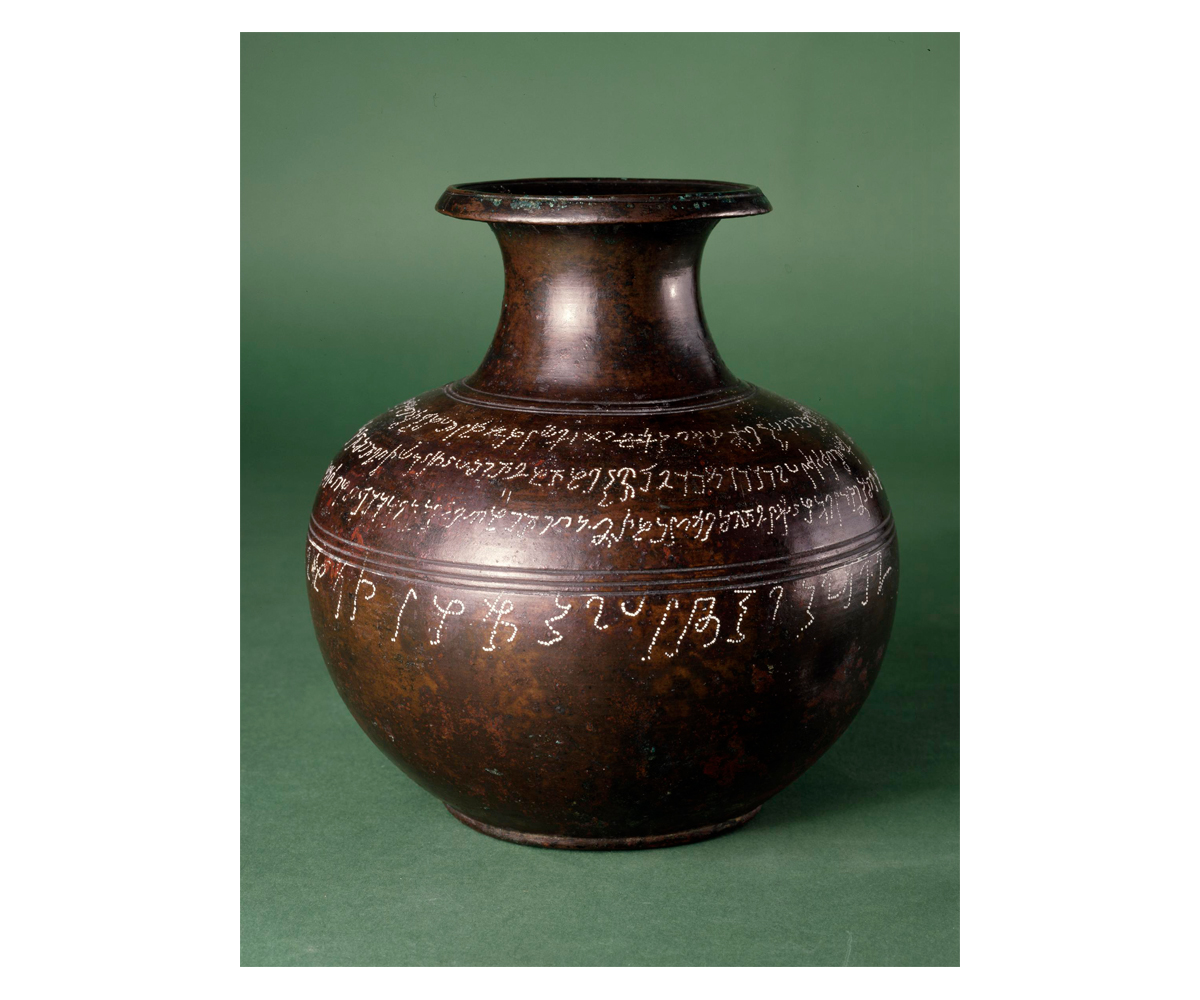ARTICLE
Wardak Vase
Dated to the second century CE, the Wardak Vase is an inscribed copper urn found containing coins and beads, and presumed to have symbolically held relics of the Buddha. The vase was discovered by British archaeologist Charles Masson in 1836 during the excavation of a stupa in Khavada (present-day Wardak province) in east-central Afghanistan. The vase with its contents was donated as a consecration offering for the stupa, built during the reign of the third Kushan ruler Huvishka as stated in the inscription. Written in a dialect of Prakrit using the Kharoshthi script, the inscription contains details that serve as proof of the vast spread of Buddhism under the Kushan empire.
Cast using a copper alloy, the vase is 17.6 centimetres tall and has a diameter of 16.9 centimetres at its widest. It has a flat base, globular belly and a narrow neck curving outwards into a flared mouth. The highly polished outer surface is inscribed with a horizontal band of three grooves that go around the widest part of the vase, and another consisting of two grooves at the base of the neck.
Three lines of writing in the Kharoshthi script are punched onto the shoulder of the vase between the two bands. They date the foundation of the stupa to the fifty-first year of the Kushan empire (178 CE), attributing it to Vagamarega, presumably a Buddhist living in Khavada at the time. As the maker of the offering, Vagamarega goes on to make a series of dedications in the inscription, invoking the power of the Buddha’s relic to bless king Huvishka, as well as himself and all other beings, including his family, acquaintances and retinue. Along the belly of the vase just below the grooved band is a fourth line of inscription in larger characters. This places the stupa and the attached monastery in the possession and care of teachers of the Mahasanghika. One of the earliest sects of Buddhism, the Mahasanghika is considered to have shaped the development of early Buddhist doctrine, and is known to have been active in the region of Mathura, India. Its mention on the Wardak Vase is a rare piece of evidence suggesting the sect’s presence as far north as Afghanistan, and makes the find particularly significant in locating the reach of Buddhism as early as the second century.
Inside the vase, Masson found several pieces of ivory and colourful stones originally used for beaded jewellery, and sixty-six copper coins that he initially described as Indo-Scythian, but were later identified as Kushan as they bear portraits of kings Vima Kadphises, Kanishka and Huvishka. Buddhist reliquaries often contain coins, thought to be deposited simply as offerings of metal rather than for their value as money. For archaeologists, they also serve as identifiers of the time and place as well as the social status of devotees involved in the consecration of a religious monument.
During the 1830s, while employed by the British East India Company, Masson excavated almost fifty stupas in the regions of Kabul and Jalalabad in Afghanistan, a number that indicates how quickly Buddhism flourished under Kushan rule. In 2008, scholar Harry Falk published details of a similar vase found at another stupa in the same site. The vase is similar in shape and its inscription states that the relic was donated by Vagamarega’s daughter, on the same day as the Wardak Vase. This vase is currently part of a private collection.
In 1839, the Wardak Vase and the accompanying coins arrived in the British East India Company’s India Museum in London from Afghanistan. This museum closed down in 1879 and by 1880, the artefacts were transferred to the collection of the British Museum, London, where they are currently on display.
Bibliography
Baums, Stefan. “Catalog and Revised Texts and Translations of Gandharan Reliquary Inscriptions.” In Gandharan Buddhist Reliquaries, edited by David Jongeward, Elizabeth Errington, Richard Salomon, and Stefan Baums, 200–309. Seattle: University of Washington Press, 2012. https://stefanbaums.com/publications/baums_2012.pdf.
British Museum. “Charles Masson.” Collection: Biography. Accessed April 14, 2023. https://www.britishmuseum.org/collection/term/BIOG12317.
British Museum. “Reliquary; vase.” Collection: Object. Accessed April 14, 2023. https://www.britishmuseum.org/collection/object/A_1880-93.
Google Arts & Culture. “Bronze Reliquary and Kushan Coins from a Buddhist Relic Deposit.” Accessed April 14, 2023. https://artsandculture.google.com/asset/bronze-reliquary-and-kushan-coins-from-a-buddhist-relic-deposit/HAF9TZuuCl7L5w?hl=en.
Errington, Elizabeth. Charles Masson and the Buddhist Sites of Afghanistan: Explorations, Excavations, Collections 1832–1835. London: British Museum Press, 2017. https://zenodo.org/record/3355036.
Errington, Elizabeth. “Gandhara Stupa Deposits.” Arts of Asia 28, no. 2 (1998): 80–87. https://www.academia.edu/1130932/Gandhara_stupa_deposits.
Falk, Harry. “Another Reliquary Vase from Wardak and Consecrating Fire Rites in Gandhara.” In Religion and Art: New Issues in Indian Iconography and Iconology, edited by Claudine Bautze-Picron, 63–80. London: BASAS, 2008. https://doi.org/10.5281/zenodo.1287286.
Pargiter, F. E. “The Inscription on the Wardak Vase.” Journal of the Royal Asiatic Society of Great Britain and Ireland (1912): 1060–63. http://www.jstor.org/stable/25190122.







